Did you know that 0 was discovered in the land of India? And the very first well-equipped civilization (the Indus Valley Civilization) was actually settled on the banks of the Indus River in India. India has witnessed the dawn of some of the greatest religions, including Buddhism and Jainism. India has seen a lot of firsts, including the world’s first surgeon, the game of chess, yoga, etc.
India had always been a land of ancient cities of versatility, prosperity, and knowledge. The history of this country dates back to the earliest of human existence and is popularly known for its resilience and adaptability.
Join us on this journey of exploring 13 most ancient cities of India
These cities contributed the most to its history. This exploration will also include the city’s history and what it was famous for.
#1. Varanasi

Varanasi’s name echoes through various Hindu scriptures, such as the Rigveda, Skanda Purana, Ramayana, and Mahabharata, making it one of the oldest cities in India.
With the Varuna flowing in the north and the Assi flowing in the south, Varanasi (named after the 2 tributaries of the Ganges) settlements here have been known from the dawn, from the Vedic ages around 2,000 BCE. Believed to be created by Lord Shiva himself, Kashi or Varanasi is believed to be settled upon the Trident or ‘the Trishul’ of Lord Shiva and therefore is considered as one of the most important pilgrimages in India. One of the most famous and magnificent ancient cities of India.
The Kingdom of Varanasi has been mentioned in the Mahabharata, the land of the King Kashya (King of Kashi). King Kashya was the father of princesses Amba, Ambe, and Ambika, the princesses who later played an important role in the Mahabharata.
#2. Ayodhya
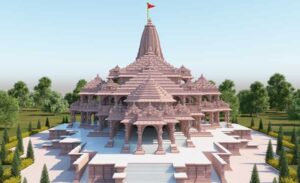
Known as Saket in earlier times, Ayodhya is one of the holiest cities in India. Its existence dates back to the epic of the Ramayana, with it being the birthplace of Lord Rama. In ancient times, Ayodhya used to be the capital of the Kosala Kingdom, with its name derived from the name Ayudh, a forefather of Lord Rama. This holy city is located on the bank of the Sarayu River and is believed to have been founded by Manu, the first of mankind.
The birth spot of Lord Rama was marked by a temple, which was later destroyed by the Mughal emperor Babur, and a Masjid was built instead. The site of Ram ‘Janambhoomi’ has forever been a matter of dispute, however, these disputes have been settled down with the construction of Ram Mandir in the disputed land and land granted in Dhannipur (near Ayodhya) for the construction of a mosque.
Don’t miss your chance to experience the most ancient cities of India and witness the captivating beauty of Ayodha
Despite all these controversies, Ayodhya has forever been a land of gods and is counted as one of the most ancient cities in India.
#3. Mathura

Mathura, a city in northern India, is considered one of the oldest continuously inhabited cities in the world. It is one of the holiest cities in India, being the birthplace of Lord Krishna. Situated on the bank of the river Yamuna, this sacred city holds a lot of significance in Hindu mythology with its ancient temples, including the Krishna Janmasthan Temple, and archaeological sites like the Mathura Museum and Kans Qila.
The city of Mathura has been known to humans since 1500 BCE, considering its mention in the Vedic Civilization. I personally believe that this ancient city of India witnessed the ancient truth and facts.
Apart from its significance in the Hindu mythologies, Mathura played a vital role for the propagation of Buddhism and Jainism as well.
#4. Delhi
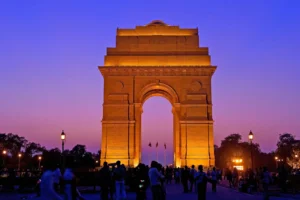
The city of Delhi has been one of the ancient cities of India that has significantly marked the historical map of the country. The area near Purana Qila, as we know it today, was once the famed Kingdom of Indraprastha. This ancient city of India dates back to the 8th–9th century and is believed to have been the kingdom given to the Pandavas as compensation for the throne of Hastinapur. Not only does it hold prominence in Hindu mythology, but it is also mentioned in Buddhist texts as Indapatta, the capital of Kuru Mahajanapada, further cementing its place in the annals of Indian history.
Originally a forest, named Khandavaprastha was given as compensation to the Pandavas for the Hastinapur Kingdom. The Pandavas cut it down to build the Kingdom of Indraprastha, a lavish one! The luxury of the kingdom made the Kauravas envious and acted as one of the reasons for the epic war of the Mahabharata.
#5. Pataliputra

The Patali tree, believed to be the very tree under which Bodhi was acquired, is what gave the ancient city of India, Pataliputra, its name. This ancient city of India was one of the largest and most fortified cities of its time, built by King Ajatashatru (4th–5th BCE) of the Haryanka Dynasty, Magadha. It is said that Buddha, during his journey from Rajgir to Vaishali, passed through this town and predicted its destiny to become a great city. Pataliputra remained the capital under successive dynasties, including the Nandas, Mauryans, Shungas, Guptas, and later the Palas, showcasing its enduring significance in the history of ancient cities of India.
The mention of Pataliputra has been made by popular historical figures like Megasthenes in his book Indica and Chinese pilgrim Fa-Hien.
Pataliputra played a crucial role in Indian history, serving as a center of power, culture, and trade. It witnessed the rise and fall of a great empire and offers valuable insights into the history and heritage of India.
#6. Ujjain
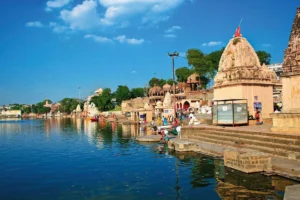
The city of Ujjain is yet again one of the oldest in India, dating back to the 6th century BCE. The city is a popular Hindu pilgrimage site for the presence of the Mahakaleshwar Temple (one out of the twelve Jyotirlingas). Ujjain was once the capital of the Avanti Kingdom, one of the sixteen Mahajanapadas mentioned in ancient Indian texts.
Ujjain was considered the traditional zero meridian in ancient Indian geography, serving as the reference point for longitude measurements. This geological point made Ujjain an important site for astronomical research and study. As one of the ancient cities of India, Ujjain played a crucial role in advancing the understanding of time, space, and celestial movements, further cementing its place in the history of ancient cities of India
#7. Lothal
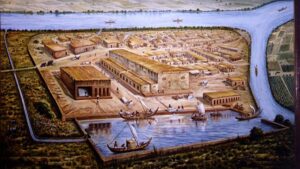
One of the most prominent ancient cities of India during the Indus Valley Civilization, Lothal is renowned for having the world’s oldest known dock, dating back around 4,500 years. This ancient city of India played a vital role in connecting the Indus Valley Civilization with other ancient civilizations, such as Mesopotamia, and served as a major trading hub. Lothal’s strategic location facilitated the exchange of goods like beads, gems, and ornaments across vast distances.
Researchers have also discovered that Lothal was a center of bead production, with numerous artifacts related to bead-making unearthed at the site.
The city was rather a planned one with symmetrical roads crossing at 90 degrees and attached toilets with flush system. The sewage system was much advanced in their times, and the city also consisted of systemized public gathering places such as the Great Bath, granaries, etc.
#8. Khajuraho

Khajuraho is yet another ancient city of India with a rich historical background. During the reign of the Chandela Dynasty in the 11th century AD, Khajuraho served as the capital city of the Chandela kingdom.
The renowned group of temples in Khajuraho, built by the Chandelas around the 10th and 11th centuries AD, remains a testament to the architectural brilliance of that era. These temples, now part of the Khajuraho Group of Monuments, a UNESCO World Heritage Site, highlight the ancient city’s exceptional cultural and historical significance, further solidifying Khajuraho’s importance among the ancient cities of India.
The intricate carvings also include erotic sculptures, which are believed to symbolize love, fertility, and the cycle of life. Other carvings include Gods and Goddesses, Hindu Mythologies, and other celestial bodies.
#9. Hampi
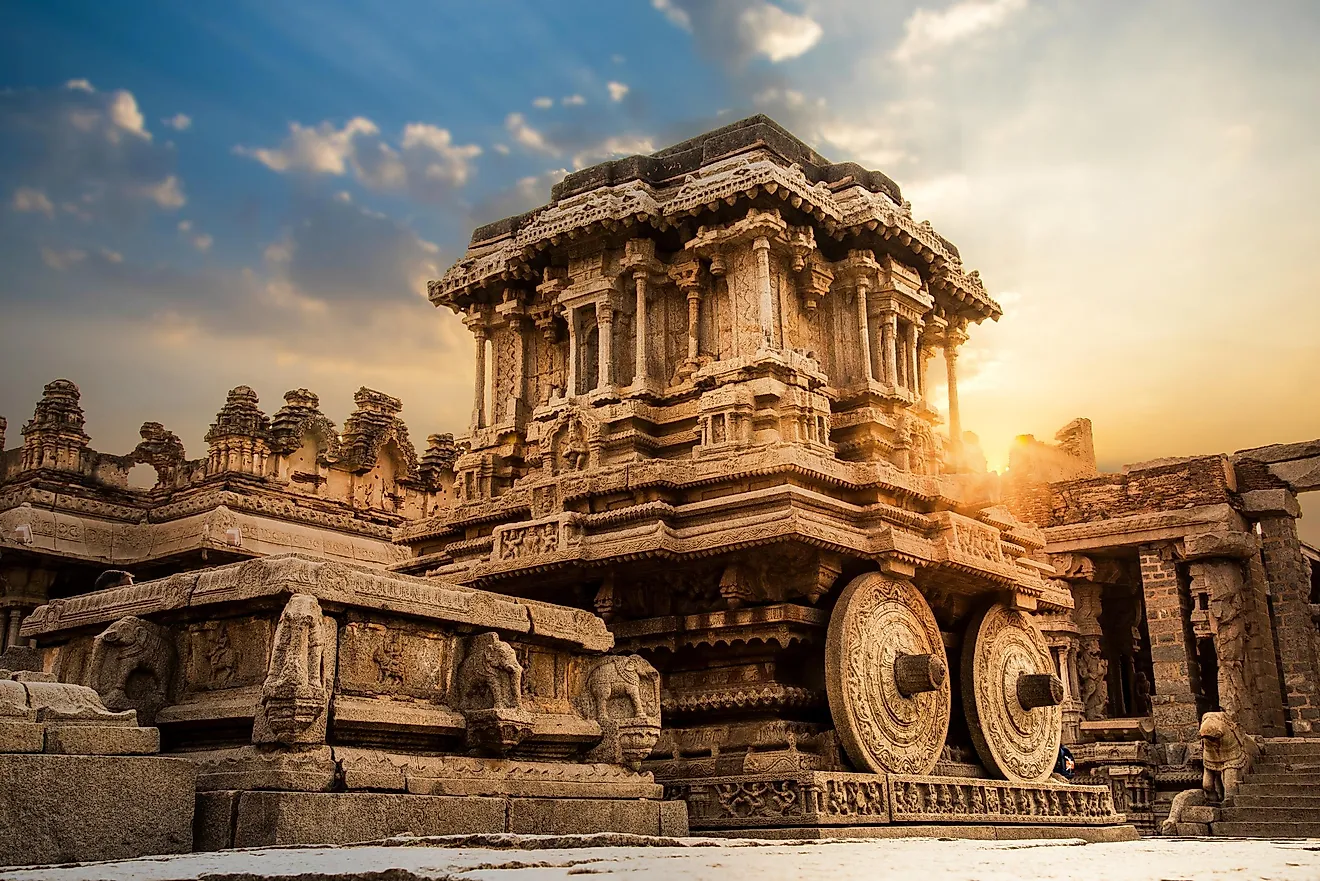
#10. Kanchipuram
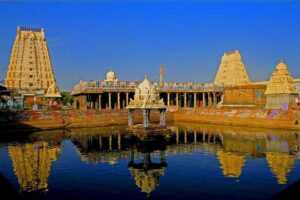
Kanchipuram’s ancient heritage is a result of its historical significance as a center of power, trade, and religion.
#11. Nalanda
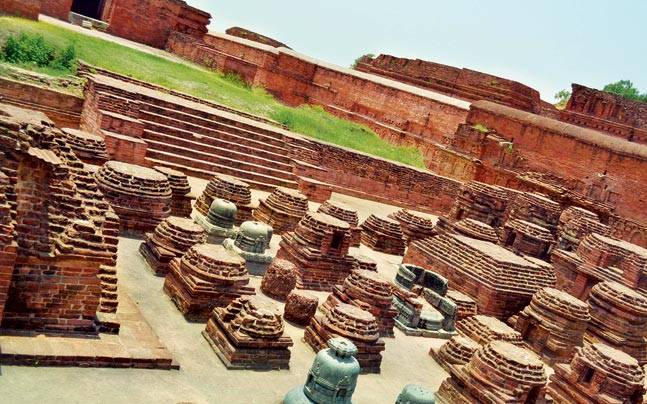
Nalanda’s rich history has a lot to do with the renowned Buddhist University, bringing in both cultural and intellectual influences.
#12. Taxila

The University of Taxila attracted scholars from all over the world to come and dive into the insights of this place. From the monumental Buddhist stupas to the intricate Hindu temples to the ancient university, the history of this ancient city, despite of its landmarks, is worth a read.
#13. Somnath

The ancient city of Somnath has been mentioned in ancient Hindu scriptures like the Skanda Purana and the Rig-Veda. Popularly known as Prabhas Patan in the ancient scriptures, the Somnath Temple is believed to have been built by the Sun God himself. The further mention of Somnath is in the epic Mahabharata, a city of the south where the Saraswati River merges with the sea. The Paanch Pandav Gufa in the city of Somnath is believed to have been made by the Pandavas.
CONCLUSION
If you’re someone who is fascinated about how different rulers shape a city, check out: Delhi the Pheonix City: A City with 7 Lives – ItihaasKiKhoj

